By Chantal Sicile-Kira, BA
Editorial Note: This article originally appeared in Family Therapy Magazine in May/June 2008
Family life is all about relationships and communication: relationships between two people in love, parents and children, siblings, extended family members. Yet, autism spectrum disorders (ASDs) are all about communication challenges, misunderstanding of social cues, and lack of emotional understanding, thus affecting every relationship in the family. In marriage, if one of the partners is on the spectrum, there will be more difficulties than the usual marital conflicts. Sibling issues are exacerbated by having an autistic sibling and/or a parent on the spectrum. Communication and social challenges can also impact the adult’s work situation. Before looking at how to best provide support, a better understanding of the particular difficulties autism infuses into the family unit is necessary.
Autism: It’s a Family Thing
It has been estimated that the divorce rate is in the 80% range in families with children who have autism (Bolman, 2006). Despite high rates of marital conflict, many couples do not reach out for couples therapy. Lack of respite is a major reason. For most, finding a babysitter with whom then can safely leave an autistic child who has toileting issues, little communication skills, aggression and other inappropriate behaviors on a regular basis is difficult (Sicile-Kira, 2004). Another reason is their lack of belief that they will find a therapist understanding of their particular circumstance and offer any true guidance, thus preferring to use the precious time away from the child to confide in a good friend.
Marital stress around the child usually starts when one or both of the parents realizes the child is not developing properly. Couples who have a child who does not seek their attention in the usual way (i.e., eye contact, reaching out for or giving of affection, searching them for comfort when hurt) find it hard not to feel rejected or unimportant to the child. For those whose child develops normally and then regresses around 18-24 months, there is the added loss of the child they knew slipping away. Consider also that a couple looks forward to having a child, and each person had his idea of what the expected child will be like. When the child does not match the expectation, or regresses, there is a loss and anguish felt by the parent not unlike the stages of grief that people who lose a loved one experience (Sicile-Kira, 2004).
Other stages of added stress are: getting a diagnosis (family physicians are reluctant to make a diagnosis on a condition once rare for which they have no set treatment plan to prescribe); getting services (a constant struggle); dealing with adolescence (sexual development appears, uncontrolled tantrums can be dangerous as the teen gets bigger); and post high school (the realization that few adult services are available) (Sicile-Kira, 2006).
Keeping any marriage healthy takes time, and all too often, time gets swallowed up by the autistic child’s needs. Many children with an ASD have difficulty sleeping, meaning that at least one of the parents is sleep deprived. Usually, a role division takes place as one parent, usually mom, becomes the autism expert, while dad works harder to earn money or opts out. Differences of opinion exasperate an already difficult situation – how much time, energy and money is to be spent on helping the child is based on personal philosophy, and in this the couple may clash. Over time, dad becomes frustrated at the demands of their wives to interact or play with a child who does not know how, and moms become frustrated at the lack of involvements of their partners.
As well, a common pattern among moms is to wonder what they did wrong – drinking or taking medications during pregnancy, exercising too much, allowing the child to be vaccinated, thus adding feelings of guilt to an already stressful situation. Also, the couple eventually feels isolated because they feel it is hard to take an autistic child to people’s homes and are uncomfortable inviting people over.
Sometimes the couple becomes closer than ever, bonded in their shared circumstances. Unfortunately, usually the stress of dealing with autism and all it entails – the constant and necessary advocacy at school, the fighting for services and supports, the added financial burden, trying to handle behaviors and meltdowns at home – becomes a wedge pushing the spouses further and further apart. Overwhelmed, stressed and exhausted, the couple’s communication becomes impaired and even autistic-like, lacking emotion and reciprocity. This can affect other children in the family.
Grandparents
Unlike the parents who are totally focused on the autistic child’s needs, grandparents are concerned about the effects of autism on their adult children (the parents), other grandchildren and future generations. They also suffer stress similar to that of parents and siblings. Grandparents are concerned about the difficult situations they see their own children experiencing. They may provide the autistic child’s parents (who may be depressed, single, or divorced) with necessary support in the way of childcare, financial support and advocacy. But, they may also contribute to stress because of conflict regarding behavioral symptoms and treatment (Hillman, J. 2007). Sometimes grandparents get involved in the blame-game about the possible causes of the child’s autism, which can be particularly terrible if the couple splits up and there are disputes over custody.
Grandparents may want to help by babysitting, but most do not have the training in behavior management or may not have the physical strength required to handle behavioral episodes. They may just want to play with the child and spoil him/her, and end up feeling rejected by the lack of ‘typical’ exchange.
Siblings
The challenges of having a brother or sister on the spectrum can have both positive and a negative effects on a sibling. The factors that affect how a sibling adjusts include: family size, severity of the brother or sister’s impairment, age of the sibling at the time of the diagnosis, gender and age of sibling, and their place in the birth order. The parents’ attitudes and expectations have a strong bearing on how a sibling adjusts.
Many siblings develop a maturity and sense of responsibility greater than that of their peers, take pride in the accomplishments of their brother and sister and develop a strong sense of loyalty. Siblings of ASD children are usually more tolerant of differences in people and show compassion of others with special needs. However, many siblings feel resentment at the extra attention the child with autism receives, and some feel guilt over their good health. When little, they may think they can ‘catch’ autism from their sibling. They may also feel saddled with what they perceive as parental expectations for them to be high achievers. Many feel anxiety about how to interact with their brother or sister, and feel rejected by the lack of reciprocality. Often there is a feeling of resentment at having to take on extra household chores, coupled with restrictions in social activities. When one of the parents has AS, this creates another set of challenges.
An Asperger Marriage
As Asperger’s Syndrome (AS) has only been recognized since 1994, there are many adults with AS who have been misdiagnosed and treated for mental illness. Although traditionally 3 out of 4 children diagnosed with an ASD are male, there is growing consensus that there may actually be more females with Asperger’s Syndrome who have been misdiagnosed with other conditions. Keep in mind that the information below is based on heterosexual partnerships, although same- gender relationships occur just as it does in the population as large.
Sometimes the diagnosis of an adult follows that of their child, sometimes it follows marriage therapy, and sometimes it is problems at work that finally lead to a diagnosis. A spouse may seek out a therapist with complaints of a cold, uncaring, and unemotional husband, although she may have chosen her mate because he appeared calm and reliable. An AS adult may appear depressed because of the flat affect, monotone and lack of direct eye contact. Others may appear controlling and rigid, insisting everyone in the household stick to the same schedule and participate in the same activities, due to a need for sameness and inability to empathize. It is this lack of empathy that has the biggest impact on the partner with AS ability to understand their spouses, as well as any children, and to recognize that their needs, perceptions and thoughts are different from their own (Aston, M. 2005). Poor empathy in the AS parent may contribute to behavioral and psychological problem in the children. However, a parent with AS, may be better able to better understand and cope with the a child who has the same diagnosis.
Anxiety and stress can run high in adults with Asperger’s due to the difficulties in communication and social interaction. Most lack what we think of as ‘common sense.’ Body language and subtexts of intonations are lost on them, so that they may hear the words that were spoken, but not understood the real message or context. Persons on the spectrum can be honest to a fault and may make inappropriate comments in public, thus appearing rude and uninterested in social situations.
These same communication problems effect a person’s ability to keep a job or move up the corporate ladder. Temple Grandin PhD, author of Thinking in Pictures and animal scientist, often speaks about how she almost got fired from her first important job because she kept writing letters to the CEO telling him how he could improve the company. She had no clue that the hierarchy at work dictated how, what, and to whom you communicate. Often times when a company is downsizing, the people laid off are the those who did not establish social relationships at work.
Physical demonstrations of affection can be difficult for those adults who suffer from sensory processing disorder and are overly sensitive to touch. Often the AS spouse is surprised that his partner and children are feeling unloved and unsupported, not realizing that his behavior does not show the support and love he says he has for them. The inability to read non-verbal communication makes it difficult to differentiate between when their partner wants to have intercourse or just a snuggle. Some couples report that the partner on the spectrum insists on routine even in sexual activity (Aston, M. 2003).
Finding out that a partner has an ASD can provoke different feelings. One of them is anger at missing out on aspects of a marriage that the partner was looking forward to. Another feeling is relief that the partner is not trying to shut the other one out, he is just unable to provide the emotional response needed (Slater-Walker, C., and Slater-Walker, G. 2002). For children the reaction is similar. The positive aspects of having a spouse with Asperger’s can include the realization that they are in most cases loyal, honest and dependable. Those who are diagnosed as adults who knew they were different feel empowered and relieved once they receive the diagnosis, as now they have a starting point for finding strategies that are helpful (Carley, M. 2008).
How Therapists Can Help
There many ways in which therapists can help the family unit. For all those who need more information or need access to a support group and are not yet hooked into recourses, the Autism Society of America has local chapters that can be helpful. www.autism–society.org
Couples need to be encouraged to acknowledge and face the emotions of the grief cycle (i.e., denial, grief, depression, anger) and the loss of the child they were expecting, and to work through these emotions. Misdirected anger is often released at school personnel in Individualized Educational Program (IEP) meetings or taken out on service providers, thus alienating the very people who are there to help them.
Encouraging couples to regularly schedule time together without the children is important. However, this suggestion is useless unless the therapist can support them in devising a practical plan for finding the respite help they need.
The lack of qualified babysitters can be a very real obstacle to finding time together or continuing therapy. Working on good communication skills and looking at how they can support each other is important. The couple needs to realize and accept that their partner may react differently to having an autistic child and a different viewpoint when it comes to how much effort and money to put into treatment, as well as what kinds of treatments to pursue.
Encouraging dads to take a more active role with agreed upon treatments, generalizing some of the skills the child has learned through his ABA (Applied Behavioral Analysis) program, helping with structure, limit setting and discipline can be very helpful. For this to occur, dad needs more information and training. Perhaps coming up with some dad-oriented informational materials could be useful. A good on-line support group for dads is http://www.fathersnetwork.org/
In the same way, providing available and willing grandparents with information and a little training that can enable them to step in and give the parents a few hours of respite can be beneficial to all involved. Explaining to them why their grandchild acts they way they do (i.e., sensitivity to sound and light, not being able to make sense of the world, lack of communication skills) is helpful. Suggesting they offer to do a specific task, such as teaching the child to catch and return a ball or play a simple game, or teach a simple learning skill which needs much repetition and positive reinforcement, can be helpful. In this way they could understand both the effort needed and the excitement to be had in teaching their grandchild an interactive skill. Grandparents will feel empowered knowing they are making a positive difference in the family’s life, the parents will feel supported and more relaxed. Information geared towards grandparents can be found on the Grandparent Autism Network at http://www.ganinfo.org/organization.aspx
To the non-autistic sibling, knowing that they can ask questions and discuss their feelings about their sibling and autism is important. By helping parents understand the needs that siblings have is helpful, as sometimes these get lost in the shuffle. The non-autistic children need some quality time alone with their parents on a regular basis Parents need of be aware of the sibling’s feelings in order to develop strategies of support to help him/her adapt.
Providing the siblings with information about autism (such as why their sibling acts they way he does) in a positive manner at their age level is necessary, and there are many children’s books available now that that can be very helpful. Joining a support group for other siblings of special needs children can be extremely helpful so they do not feel they are the only ones going though this, see www.siblingsupport.org/sibshops for more information.
The siblings need to be reminded often that they have just as much of their parents’ love as their autistic sibling, even if parents may need to give more time and attention to their brother or sister with autism. It is important that the non-autistic sibling have a private autism-free zone to call their own, and a secure place to keep their precious objects. They also need to see that the sibling with ASD is given consequences if he wrecks their things, and that he is expected to improve his behaviors over time. For children of an AS parent,
For a mixed marriage between an Asperger and a non-autistic partner to work, each spouse needs to recognize the differences they have and why. If the partner with Asperger’s refuses to acknowledge that his behaviors and actions towards his/her partner are unacceptable, then there is little hope for the relationship.
Understanding the deficits, reinforcing the strengths and acknowledging the needs of each partner is helpful. Teaching the willing AS partner behaviors that are important to his spouse (such as greeting her when he walks in the house, asking about the partner’s day at work, giving her a kiss) is effective. Research for my new book (Autism Life Skills to be published by Penguin October 2008) indicates that those willing to learn can be taught expected behaviors and strategies. Some of these include teaching them the ‘hidden curriculum’ (i.e., what non-autistics automatically learn and take for granted, making lists for visual learners). For more social competence at work, having a mentor there who can explain the non-autistic expectations, and writing a list or drawing a map of the hierarchy and expected communications at each level can be well-worth the effort. GRASP – The Global and Regional Asperger Syndrome is a good on-line network for people on the spectrum www.grasp.org Information for partners and families can be found on these two websites : Asperger Syndrome Partners & Individuals, Resources, Encouragement and Support. www.aspires-relationships.com ; Families of Adults Affected by Asperger’s Syndome wwww.faaas.org.
Author Biography
Chantal Sicle-Kira, BA is President of Autism Making A Difference,Inc. which provides consultation, training and seminars on ASDs. city guides Satellite map She is the author of Autism Spectrum Disorders (2005 ASA Outstanding Book of the Year), and Adolescents on the Autism Spectrum Disorder, both published by Penguin. Her third book Autism Life Skills will be published Oct 2008.
References
Aston, M. 2003. Aspergers in Love: Couple Relationships and Family Affairs. London: Jessica Kingsley Publishers.
Aston, M. 2005 “Growing up in an Asperger Family.” Counseling Children and Young People (CCYP) Journal.
Autism Society of America, 2008. “Family Life.” http://www.autism-society.org
Bolman, W. 2006. “The Autistic Family Life Cycle: Family Stress and Divorce.” asa.confex.com/asa/2006/techprogram/s1940.htm.
Carley, M. 2008 Asperger’s from the Inside and Out: A Supportive and Practical Guide for Anyone with Asperger’s Syndrome. New York: Perigee.
Hillman, J. 2007. “Grandparents of Children with Autism: A Review with Recommendations for Education, Practice, and Policy.” Educational Gerontology, P 513-527.
Sicile-Kira, C. 2006. Adolescents on the Autism Spectrum: A Parent’s Guide to the Cognitive, Social, Physical and Transition Needs of Teenagers with Autism Spectrum Disorders. New York: Perigee.
Sicile-Kira, C. 2004. Autism Spectrum Disorders: The Complete Guide to Understanding Autism, Asperger’s Syndrome, Pervasive Developmental Disorder, and Other ASDs. New York: Perigee.
Slater-Walker, C., and Slater-Walker, G. 2002. An Asperger Marriage. London: Jessica Kingsley Publishers.








